新版《船舶垃圾管理计划》
前 言
Introduction
1. 本计划是根据《经1978年议定书修订的1973年国际防止船舶造成污染公约》(以下称73/78防污公约)附则V1995年修正案第9条规定的要求编写的。
This plan is developed in accordance with the requirements of regulation 9 of Annex V, as amended in 1995,of the protocol of 1978 relating to the 1973 International Convention for pollution from ships (hereinafter called MARPOL 73/78) regulatory requirements.
2. 本“计划”包括了国际海事组织制定的“垃圾管理计划编制指南”所要求的全部资料和操作程序。
This plan contains all information and procedures stated in Guidelines for the development of the garbage management plan adopted by the International Maritime Organization.
3. 本计划须经中华人民共和国广州海事局批准。
This plan has been approved by Guangzhou Maritime Safety Administration of The Peoples Republic of China.
4. 本“计划”是为本船船员在船上使用。以船员使用的工作语言编写。
This plan is provided for shipboard crew members to use and developed in crew’s working language.
5. 本船全体船员应严格按本“计划”有效地管理垃圾,防止水域污染。
All crew members onboard must handle and dispose garbage in strict compliance with this plan to prevent garbage pollution.
垃 圾 管 理 计 划
GARBAGE MANAGEMENT PLAN
1.《垃圾管理计划》实施人员职责
Responsibilities for persons to carry out the garbage management plan
1.1 总负责人职责
Responsibilities for designated person in charge
本船《垃圾管理计划》实施总负责人是本船船长,其主要职责是:
The designated person in charge of carrying out the garbage management plan is the ship master, who is responsible for:
(1) 负责垃圾管理计划在船上全面贯彻实施;
Implementation of the garbage management plan onboard comprehensively;
(2) 负责组织全体船员的培训、教育工作;
Training all the crew members;
(3) 船舶发生垃圾污染事故时,组织船员进行应急处理并及时报告主管机关。
Commanding all crew to take emergent measures in case of a garbage pollution incident and reporting to the administration authority.
1.2 具体实施负责人职责
Responsibilities for designated support staff
本船《垃圾管理计划》具体实施负责人是本船大副。其主要职责是:
The designated support person in charge of carrying out the garbage management plan is the chief officer, who responsible for:
(1) 负责组织垃圾管理人员实施垃圾管理计划;
Organizing all crew members involved to implement the garbage management plan;
(2) 负责垃圾管理人员培训和训练工作;
Training of crew members involved in garbage-management;
(3) 船舶发生垃圾污染事故时,现场指挥应急处理工作;
Commanding the emergent actions on site in case of a garbage pollution accident;
(4) 负责联系垃圾接收处理事宜;
Disposal of garbage to the port reception facilities;
(5) 负责垃圾记录簿记录和保管。
Making entries and keeping of Garbage Record Book.
1.3 垃圾收集处理人员职责
Responsibilities for garbage-collected persons
(1) 船上的服务员负责日常垃圾收集、处理工作;
Waiters are responsible for daily-garbage collection and handling;
(2) 负责分类、收集处理垃圾;
Waiters are responsible for categorizing and collection;
(3) 保持垃圾收集、储存点的卫生,不发生污染、腐烂、恶臭气味。
Keep collection of garbage and sanitation of storage site, no pollution, decay and effluvium.
1.4 垃圾处理设备管理人员职责
Responsibilities for persons involved in operating the garbage processing equipment
(1) 熟悉所分管的设备技术性能并严格按垃圾管理程序进行操作;
Be familiar with technical specifications of the garbage handling equipment and operate in strict accordance with the garbage management procedure;
(2) 负责所分管的设备维修与保养,使其处于良好状态。
Responsible for maintenance of the garbage processing equipment and keep it in good order.
1. 5 全体船员职责
Responsibilities for all crew
(1) 严格遵守《垃圾管理计划》的要求;
To observe the requirements of the garbage management plan strictly;
(2) 认真参加《垃圾管理计划》的培训和演习;
To participate actively in training and drill relating to the garbage management plan;
(3) 船舶发生垃圾污染事故时,按大副指令参加应急处理工作。
To participate in emergency response according the chief officer’s orders in case of garbage pollution incidents.
2. 船舶垃圾管理原则及减少垃圾的措施
Management principles of the garbage management and measures to reduce ship garbage.
2.1 本船垃圾采取分类收集和储存,按不同要求加工和处理;
The garbage onboard is collected, stored and processed according to its category;
2.2 本船垃圾在船舶离港前尽可能申请港方接收处理,尽量减少在海上的排放量;
The garbage onboard should preferably be disposed of at the port reception facilities before departure, and not retained onboard, so as to reduce the amount discharged at sea when possible;
2.3 本船在海上排放处理垃圾时,严格遵守《73/78防污公约》附则V的规定;
While handling the garbage onboard at sea, the requirements of Annex 5 MARPOL 73/78 must be strictly observed;
2.4 进行垃圾处理作业时,按要求如实填写《垃圾记录簿》;
The entries must be made in the Garbage Record Book on each occasions of garbage disposal strictly according to the requirements;
2.5 全体船员尽量少带容易产生垃圾的物品上船;
Goods that is liable to generate garbage and carried onboard by crew should be limited when possible;
2.6 尽量选用可降解的包装袋和可重复使用的容器包装或储存物品,以便减少;垃圾的产生量;
Decomposable packaging, reusable packaging and use of containers are selected to reduce the garbage when possible;
2.7 尽可能选用重复使用的盖布、垫板、衬板和填充材料;
Reusable covering, dunnage, shoring, lining and packing materials should be selected when possible;
2.8 在港内卸货、修船时,产生的垫舱物料和修船垃圾,应及时送往港口接收设施。
Dunnage, lining and packing materials generated in port during cargo discharge and, maintenance wastes generated during ship-repairs should preferably be disposed at the port reception facilities timely.
3. 发生垃圾污染事故时的反应
Responses in case of a garbage pollution incident
3.1 当发生垃圾污染事故时,应及时采取控制、回收等措施,减少污染;
Measures to control the spread of and recollect of garbage should be taken to reduce pollution in case of garbage pollution incidents;
3.2 船长或大副及时向主管机关报告,内容主要包括:
The ship marster or chief officer should report the particulars of such incident to the administration authority without delay, main report particulars shall contain in general:
(1) 船名/呼号
The ship name/call sign
(2) 船籍港
The ship’s flag port
(3) 日期和时间
The date and time of occurrence of the incident
(4) 船舶位置
The geographic position of the ship when the incidents occurred
(5) 发生的垃圾污染状况、垃圾种类及估计量
Description of garbage pollution, category of garbage and estimate amount
(6) 原因
Reasons
(7) 采取的应急措施
Emergency responses
(8) 船舶所有人/经营人
Ship owner/manager
4. 垃圾收集程序
Garbage collection procedures
4.1 收集容器
Collection receptacles
4.1.1 船上设有桶、袋、箱,三种分别有明显标记区别,用于收集不同类型垃圾用的容器;
Three kinds of receptacles, namely barrels, bags and boxes should be clearly marked and distinguished by color, graphics, shape, size or location for collections;
(a) “红色”标记的容器用于收集塑料和混有塑料制品的垃圾
Red receptacles for plastics and plastics mixed with non-plastics garbage
(b) “绿色”标记的容器用于收集食品废弃物
Green receptacles for food wastes
(c) “蓝色”标记的容器用于收集能在海上处理的垃圾
Blue receptacles for other garbage which can be-disposed of at sea
4.1.2 收集垃圾用的容器分别放在餐厅、厨房、卫生间、盥洗室、船员生活区走廊、机舱和甲板等处所;
Receptacles for garbage should be placed in dining room, kitchens, washing-room, toilets, gallery space, engine room and bridge room, etc.
4.1.3 垃圾收集管理人员应及时将各收集点的容器排空或收集,按不同类型分别送往加工点、短期储存点或长期储存点。
Crew members responsible for collection should empty receptacles in each locations and send each category garbage to disposal site, short-term and long-term storage sites.
4.2 收集程序
Collection procedures
4.2.1 塑料垃圾(包括混有塑料的其他垃圾)全部留存在船上,到港后送往港口接收设施处理;
Plastics garbage, including plastics mixed with non-plastics garbage must be retained onboard for discharge to port reception facilities;
4.2.2 含油抹布和已污染的破布送焚烧炉焚烧或到港后送往港口接收设施处理;
Oily-rags and contaminated rags should be incinerated or be disposed of to port reception facilities;
4.2.3 对带有病菌的食品废弃物及其用具与其它垃圾分开储存并妥善保存,到港后按照接收国法律规定送往港口接收设施处理。
Foreign food wastes and associated garbage which may carry disease or pests should be kept separate from other garbage which does not contain such food wastes, and discharged to port reception facilities in accordance with the laws of the receiving country.
5. 垃圾处理程序
Garbage processing procedures
5.1 船上垃圾处理设备
Garbage processing equipment onboard
5.1.1 船上的厨房设置粉碎机……台,用于粉碎食品废弃物,由厨工负责管理使用;
There are/is …… …set of comminuter(s) in kitchen to comminute food wastes, operated by cooker;
5.1.2 本船装置……台……型焚烧炉,用于焚烧纸及其制品、浸油破布、塑料等容易燃烧的垃圾。
There are/is………set of………type incinerators to incinerate papers products, saturated oil rags, plastics and other tinder garbage;
5.2 粉碎加工处理
Comminution
5.2.1 食品废弃物,当船舶在距最近陆地3海里以外并且不在特殊区域内、经粉碎机粉碎,通过网眼不大于25mm的筛子排放入海;
Food wastes ground to particle size capable of pass through a screen with openings no larger than 25 millimeters can be discharged at sea when ship's position is beyond 3 nautical miles. from the nearest land and outside special areas.
5.2.2 船舶在禁止排放区时,经粉碎或磨碎的垃圾,排入一个贮存柜。不能排入船舶生活污水处理系统,也不能贮存在含有油污水的舱底或油舱内。
The ground or comminuted garbage should be kept in storage receptacles instead of bilge system and oily water tanks when ship is within special areas.
5.3 压实处理
Compaction
5.3.1 为便于贮存、易于输送到港口接收设备或在海上排放,对可压实的垃圾应在船上进行压实处理;
Garbage liable to be compacted should be compacted for easier storage, transfer to port reception facilities and discharge at sea when discharge limitations permit;
5.3.2 各种垃圾压实方案列于附件四;
Compaction options for shipboard-generated garbage are demonstrated in Appendix 4;
5.3.3 垃圾压实前应将体积减少以便容易送入压实机或磨碎机磨碎提高压缩率和减少贮存场所;
Garbage should be packed, ground or comminuted before compaction so as to increase ratio of compaction and decease storage space;
5.3.4 未磨碎的塑料,纤维板的纸板,体积大的货物容器和厚金属件,蓄有压力的容器等垃圾不能压实。
Ungrounded plastics, fibreboard, bulk cargo containers, thick metal pieces and pressured containers etc., should not be compacted.
5.4 焚烧处理
Incineration
5.4.1 纸及其制品、浸油破布、塑料等容易燃烧的垃圾,可在船上焚烧炉内焚烧处理;
Papers products, saturated oil rags, plastics and other tendery garbage can be incinerated in incinerators onboard when incineration limitations permitted;
5.4.2 各种垃圾焚烧选择列于附件三;
Incineration options for shipboard-generated garbage are demonstrated in Appendix 3;
5.4.3 在港口用焚烧炉焚烧垃圾需得到港口有关部门许可;
The use of shipboard garbage incinerator in port should be approved by ports authority;
5.4.4 焚烧在排气中产生有毒气体的塑料垃圾时,应在能承受高温的焚烧炉中进行焚烧;
Plastics generated poisonous gases when incinerating should be burned in incinerators which can stand higher temperatures.
5.4.5 对含有重金属或其它有毒残余物的灰渣,暂时存留在船上,送往港口接收设施处理,不得直接排放入海。
The ash from the combustion of some plastics products may contain heavy metal or other residues which can be toxic and should be retained onboard, where possible, and should be discharged a port reception facilities;
6. 垃圾贮存程序
Garbage storage procedures
6.1 本船在…………、…………、…………设置短期垃圾储存点,在…………设置长期储存点;
There are short-term storage locations in……, ……, ……, And long-term storage-locations in ………….
6.2 必须送往岸上处理的垃圾,按长期贮存要求,在长期贮存点贮存;
Garbage which must be returned to ports should be kept in long-term storage location according to long-term storage requirements.
6.3 可从船上直接处置排放入海的垃圾送往短期贮存点贮存或不贮存;
Garbage which can be discharged into sea should be kept in shout-term storage locations or disposed directly;
6.4 在贮存点垃圾分类装入罐、桶、箱、袋或其它容器内;
Garbage should be filled in bins, barrels, boxes, bags and other receptacles respectively according to its category in storage locations.
6.5 短期贮存的垃圾,当船舶航行到非禁止排放区时,可将垃圾排放入海;
Short-term stored garbage can be discharged at sea when limitations permitted;
6.6 长期贮存的垃圾必须装入有严密、坚固盖子的罐、桶、箱、袋等容器内;
Long-term stored garbage must be filled in bins, barrels, bags and other receptacles with tight and solid covers;
6.7 对带有病菌的食物废弃物及其相关垃圾,应贮存在密封容器内并标上清楚标记,准备送往港口接收设施处理。
Food wastes and associated garbage which are returned to ports and which may carry disease or pests should be kept in clearly marked sealed-containers.
7. 处理排放程序
Garbage disposal procedures
7.1 船舶在港内或禁止排放区域,将可在海上排放的垃圾送往短期储存点,按垃圾类型分别装入储存容器内,准备送往港口接收设施或船舶航行至非禁止排放区域时排放入海;
Garbage that can be discharged at sea outside special areas or port reception facilities should be filled in receptacles according to its category in shout-term storage locations when ship is in port or within special areas.
7.2 在海上直接排放垃圾时,首先确认船舶是否处于非禁止排放区域,检查要排放的垃圾是否符合排放标准;
Discharge of garbage into sea directly must be consistent with requirement of discharge and outside special areas;
7.3 对可能散落或漂浮的垃圾,经压缩加工或附加重物后再排放入海,使其容易沉底不漂浮在海面上;
Garbage that may be afloat or liable to scatter should be compacted or added weights to promote sinking.
7.4 被油类污染的垃圾,必须经严格处理达到排放标准再排放入海或送往港口接收设施;
Garbage contaminated with oil should be handled to the discharge standards before discharge into sea or port reception facilities.
7.5 装卸货物时产生的废弃物,一般都在开航前送往港口接收设施处理;
Wastes generated in port during cargo discharge should preferably be disposed of at the port reception facilities before departure.
7.6 船舶到港前船舶垃圾管理计划实施负责人作好垃圾接收计划并与港方联系,到港后及时将垃圾送往接收设施。并索取具体说明所接收垃圾估计量的收据或证明,而且该收据或证明与“垃圾记录簿”一起在船上保存二年。
To ensure timely transfer of ship-generated garbage to port reception facilities, the designated person in charge should prepare the garbage discharge plan and contact the port authority on time .A receipt or certificate specifying the estimated amount of garbage transferred should be obtained from receiving port and must be kept onboard the ship together with Garbage record Book for 2 years.
7.7 可能包含有毒或重金属残余的塑料制品的焚烧炉灰烬,均禁止处理入海,必须送往港口接收设施;
Prohibits the disposal into the sea of incinerator ashes from plastics products or which may contain toxic or heavy metal residues from other garbage, should be disposed of at the port reception facilities.
8. 培训与教育
Training
8.1 船上每季度组织一次全体船员学习“船舶垃圾管理计划”,教育全体船员严格按“垃圾管理计划”要求管理垃圾;
Training should be provided for all crew members to keep them be informed of the applicable regulations for handling and disposal, and abide by the requirements of the garbage management plan, such a program should be reviewed once every season;
8.2 首次到达一个新的港口时,及时向全体船员宣传港口对垃圾管理的规定和特殊要求等;
All crew members should be timely informed the special requirement of garbage management of port authority when the port is firstly called.
8.3 对使用或管理垃圾处理设备的船员,经培训后再上岗工作;
Crew members involved in operating the garbage processing equipment, and handling and disposing of garbage as part of their operational responsibilities should trained and qualified.
8.4 新上船的船员及时进行“垃圾管理计划”教育。
Crew members newly onboard should be trained on garbage management plan.
附件一
船上垃圾处理方法选择
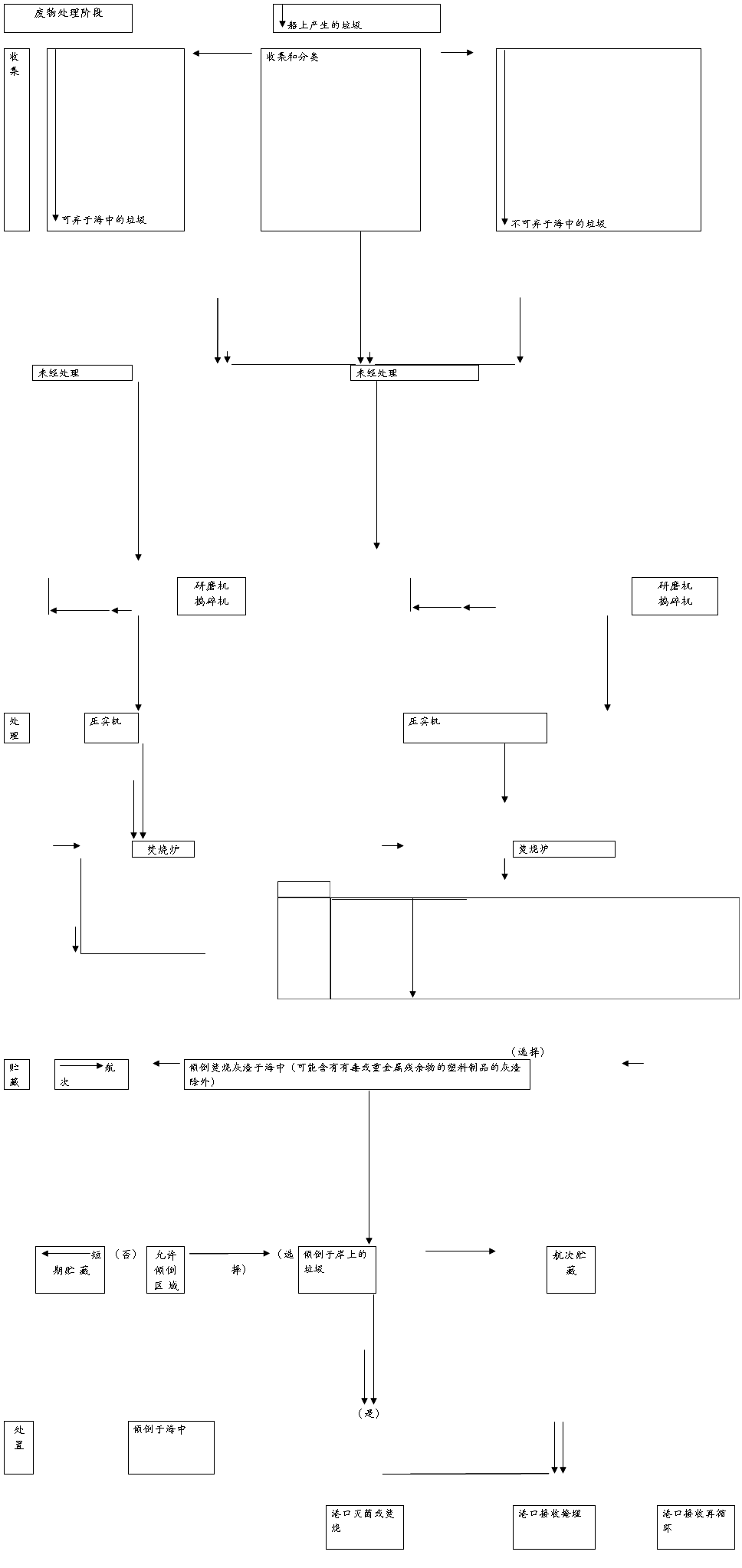
Appendix 1-OPTION FOR SHIPBOARD HANDLING AND DISPOSAL OF GARBAGE
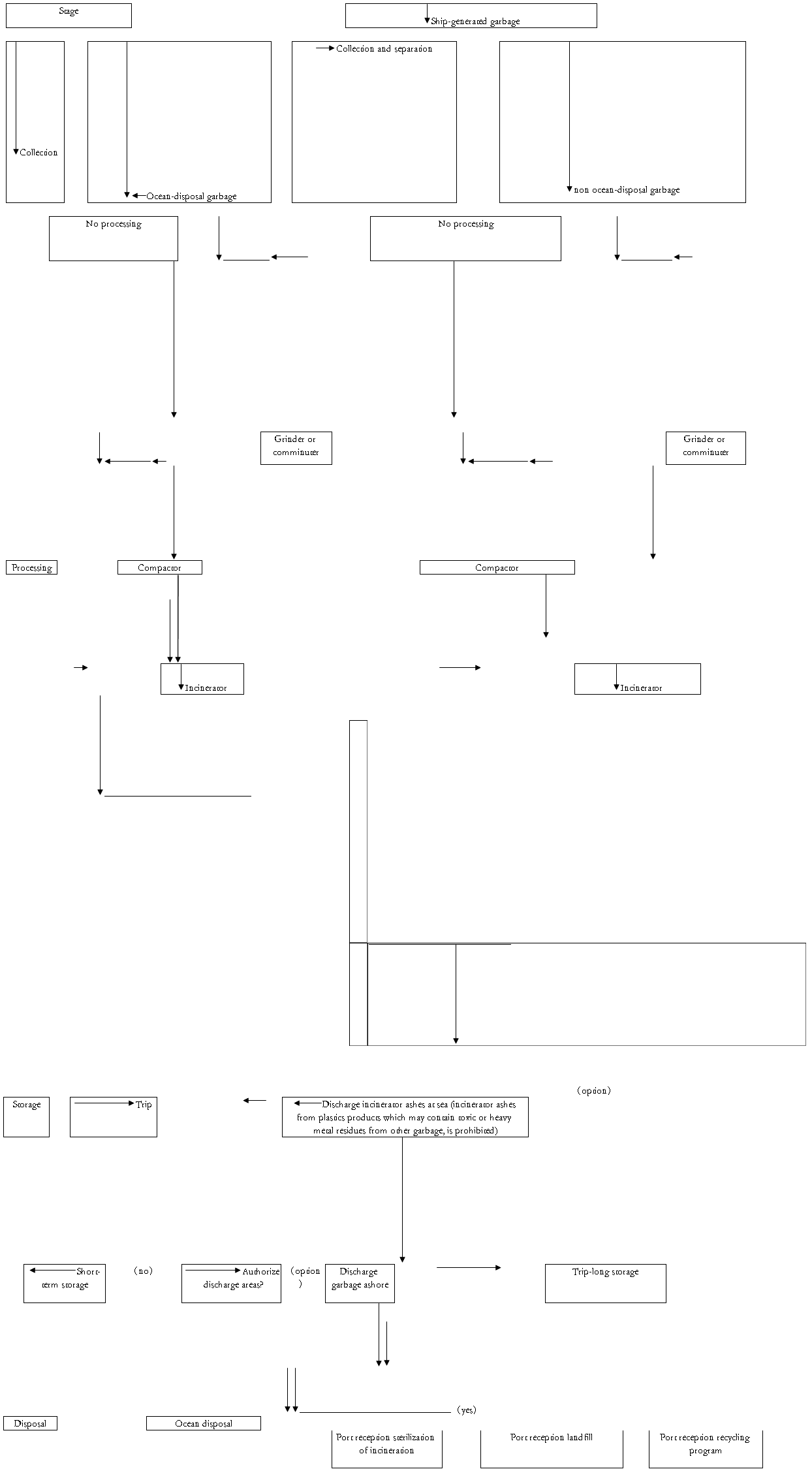
附件二
海上垃圾倾倒规则概述
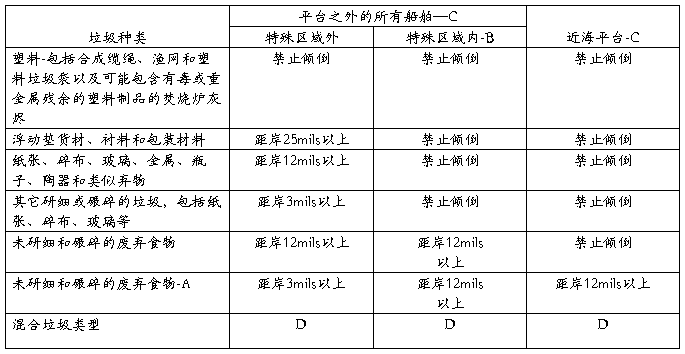
A:经粉碎或磨碎的食品废物应能通过网眼不大于25mm的筛网。
B:特殊区域垃圾倾倒规则的生效必须符合附则V第5(4)b。
C:近海平台和相关船舶系包括从事海底矿藏资源勘探或开发的固定和移动平台和所有停靠其边船舶或其周围500m内的船舶。
D:当垃圾与具有其他不同处理和排放要求的其他排放物混在一起时,其应使用其中较为严格的要求。
Appendix 2-SUMMARY OF AT SEA GARBAGE DISPOSAL REGULATIONS
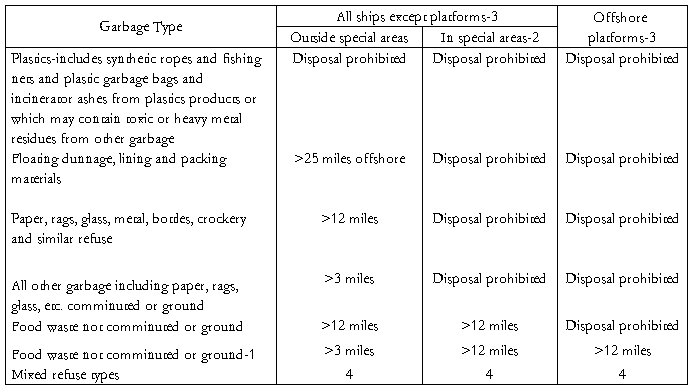
1:Comminuted or ground garbage must be able to pass through a screen with mesh size no larger than 25mm.
2:Garbage disposal regulations for special areas shall take effect in accordance with regulation 5(4)(b) of Annex V.
3:Offshosre platforms and associated ships include all fixed or floating platforms engaged in exploration or exploitation of sea bed mineral resourced, and all ships alongside or within 500m of such platforms.
4:When garbage is mixed with other harmful substances having different disposal of discharge requirements, the more stringent disposal requirements shall apply.
Note: The Baltic Sea Special Area Disposal Regulations took effect on 1 October 1989.
附件三
船上垃圾的焚烧选择*
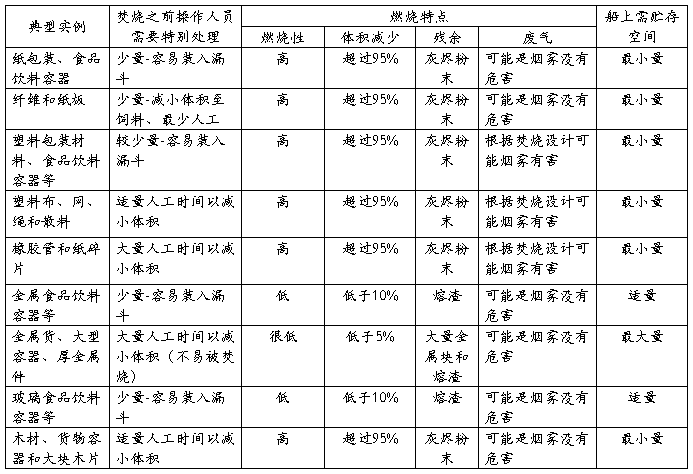
*:检查当地规范,是否有可能减少。
Appendix 3- INCINERATION OPTIONS FOR SHIPBOARD-GENERATED GARBAGE*

*: Check local rules for possible reductions
附件四
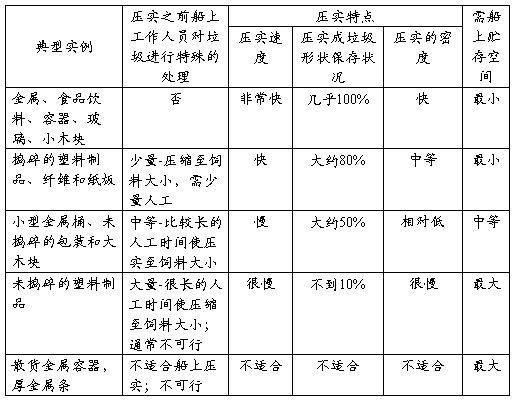
船上产生的垃圾的压实选择
Appendix 4-COMPACTION OPTIONS FOR SHIPBOARD-GENERATED GARBAGE

-
船舶垃圾管理计划
梁山华通航运公司船舶安全管理体系文件内部文件船舶垃圾管理计划前言Introduction1.本计划是根据《经1978年议定书修订的…
-
新版《船舶垃圾管理计划》
前言Introduction1本计划是根据经19xx年议定书修订的19xx年国际防止船舶造成污染公约以下称7378防污公约附则V1…
-
解读新版《船舶垃圾管理计划》(国内)
解读新版船舶垃圾管理计划国内版20xx年1月1日起新的MARPOL附则V正式生效船舶垃圾管理计划主要有以下几点大的变动1引入了新的…
-
船舶垃圾管理的新要求 - 20xx
船舶垃圾管理的新要求20xx124附则V船舶垃圾管理的新要求国际海事组织海上环境保护委员会20xx年07月15日通过的7378防污…
-
船舶垃圾管理计划
船舶垃圾管理计划15全体船员职责1严格遵守垃圾管理计划的要求2认真参加垃圾及管理计划的培训和演习3船舶发生垃圾污染事故时按大副指令…
-
船舶焚烧炉及垃圾管理计划实施的PSC检查[1]
船舶焚烧炉及垃圾管理计划的检查1法律依据MARPOL7378公约附则防止船舶垃圾污染规则于19xx年12月31日生效我国于19xx…
-
船舶垃圾管理计划
梁山华通航运公司船舶安全管理体系文件内部文件船舶垃圾管理计划前言Introduction1.本计划是根据《经1978年议定书修订的…
-
新版《垃圾管理计划》
垃圾管理计划GARBAGEMANAGEMENTPLANSHIPSNAMEMVXXXXXXIMONOCALLSIGN1234567X…
-
解读新版《船舶垃圾管理计划》(国内)
解读新版船舶垃圾管理计划国内版20xx年1月1日起新的MARPOL附则V正式生效船舶垃圾管理计划主要有以下几点大的变动1引入了新的…
-
新版船舶垃圾管理计划- MV J
垃圾管理计划MARPOL7378ANNEXVREG101前言INTRODUCTION1于20xx年1月1日生效的经修订的MARPO…
-
船舶管理站年度工作计划
富顺县安溪镇船舶管理站年度工作计划一第一季度1在1月10日前签完码头渡口客渡船发航签单目标责任书落实好签单责任制2在1月15日前搞…